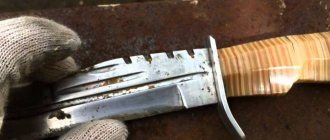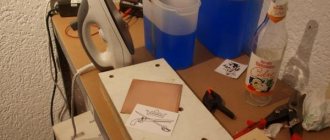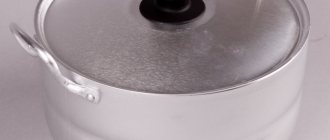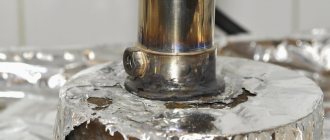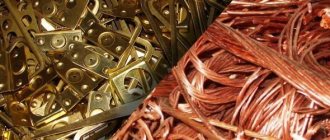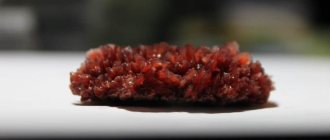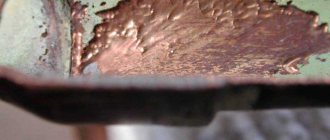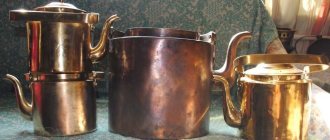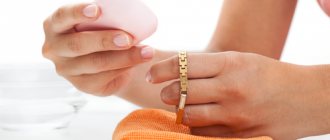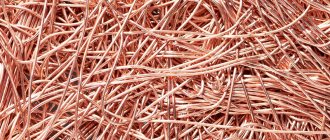by Alexey | Cleaning | Tuesday, November 02, 2021
| Follow Make-Self.net on Facebook and be the first to read our articles. |
Remove dirt and tarnish to restore the luxurious, gorgeous shine of this durable metal - on cookware, fixtures and other household items.
Although beautiful copper is not considered a precious metal, it has great value in the home, especially because of the way it handles heat. Copper is an excellent insulator and will expand and contract minimally in response to temperature fluctuations , making it an excellent cooking utensil. But anyone who has ever seen an old copper coin knows that the rich orange-gold luster of copper can easily become dull and dark, even taking on a greenish tint.
Copper Cleaning: General Rules and Cautions
Some people appreciate the patina that copper gains over time, while others prefer its shine. Luckily, copper is easy to clean, often with natural products you no doubt already have on hand in the pantry.
However, care should be taken because the copper will scratch if over-cleaned. Additionally, any brass piece with a high-gloss finish that has not discolored over time has most likely been coated with a protective varnish. These items should only be washed with water and dish detergent, as even weak acids can damage the varnish.
When removing dirt, grime and deposits from copper, follow these rules:
- To make a natural copper cleaner, mix a weak acid (such as lemon juice or distilled white vinegar) and a mild abrasive (such as salt, flour, baking soda or cream of tartar). Try to get a paste-like consistency that will stick to the copper surface.
- To avoid scratches, apply homemade cleaning paste with a soft cotton cloth and buff in the direction of the grain, up and down or from left to right. When working to clean particularly difficult areas, use only small circular movements.
- After cleaning, always rinse the copper thoroughly with water and then dry it with a clean, soft cloth.
- Delay further tarnishing after cleaning by applying a small amount of mineral oil to the entire surface.
Chemical polishing of copper
Electrochemical and chemical polishing is used both for decorative surface treatment after coating and during the processing of parts.
Electrochemical polishing
With electrochemical polishing, the surface microrelief is much smoother than with mechanical processing.
The coatings obtained by electrochemical polishing are non-porous and finely crystalline, which helps reduce the coefficient of friction and makes it possible to impart special optical properties to parts. During electrochemical polishing, the metal surface becomes shiny as a result of different rates of dissolution of microprotrusions and depressions.
The effect of electrochemical polishing is explained by the formation of a thin surface oxide film on the metal, which prevents etching.
The thickness of the film is not the same on microprotrusions and microdepressions, as a result of which the solution during electrochemical polishing has a stronger effect on those areas where the film is thinner, i.e.
on microprotrusions.
The quality of electrochemical polishing depends on the current density, electrolyte temperature, solution composition and electrolysis time.
The most widely used electrolytes based on phosphoric, sulfuric and chromic acids.
To increase the viscosity of solutions, glycerin and methylcellulose are introduced.
Sulfureide, triethanolamine, etc. are added to electrolytes for electrochemical polishing as etching inhibitors.
Chemical polishing
The chemical polishing method has much in common with the electrochemical polishing method.
The appearance of shine on the surface of parts here, as with electrochemical polishing, is also associated with the presence of a thin film that prevents etching in the metal recesses.
The preferential dissolution of protrusions during chemical polishing is achieved both due to their increased chemical activity and due to the higher rate of diffusion of metal ions and fresh electrolyte.
Electrochemical polishing of steel parts.
Comparative characteristics of electrochemical and chemical polishing processes
The main advantages of the electrochemical polishing process are high productivity, good adhesion of galvanic coatings to the electropolished surface, and the ability to eliminate the degreasing operation necessary for mechanical polishing.
The disadvantages of the electrochemical polishing process include the need to frequently change electrolytes due to the lack of a universal one for various metals; the need for mechanical polishing of the surface before electrochemical polishing; increased energy consumption.
The advantage of chemical polishing over electrochemical polishing is that it does not require the use of constant power sources.
Chemical polishing is mainly applied to brass or aluminum parts of any complex configuration and size that do not require a mirror finish.
The disadvantages of chemical polishing compared to electrochemical polishing are lower gloss, greater aggressiveness of solutions and their fragility.
Compositions of electrolytes for chemical and electrochemical polishing of metals
Most electrolytes for electrochemical polishing of steel are based on mixtures of solutions of orthophosphoric and sulfuric acids with the addition of chromic anhydride.
Electrochemical polishing electrolyte containing 500–1100 g/l phosphoric acid, 250–550 g/l sulfuric acid and 30 g/l chromic anhydride is universal for electrochemical polishing of all types of steel, including 12Х18Н9Т. Electrochemical polishing mode: temperature 60–800C, current density 15–80 A/dm2, time 1–10 minutes.
For electrochemical polishing of steel 12Х18Н9Т it is possible to use electrolytes containing surfactants.
Metal removal during electrochemical polishing occurs more intensively in the electrolyte: phosphoric acid 730 g/l, sulfuric acid - 580–725, triethanolamine 4–6 g/l, catapine 0.5–1.0 at 60–800C, current density 20–50 A /dm2, time 3–5 minutes.
Chemical polishing of steel , in contrast to electrochemical polishing, is used less frequently, although it is easier to use and has a number of advantages.
The solution for chemical polishing of steel 12Х18Н9Т contains (g/l): sulfuric acid 620–630, nitric acid 60–70, hydrochloric acid 70–80, sodium chloride 1-12, acid black dye 3M 3–5.
Temperature 70–750C, time 5–10 minutes.
For electrochemical polishing of copper and its alloys, solutions of phosphoric acid with chromic anhydride are used: phosphoric acid 850–900 g/l, chromic anhydride 100–150 g/l, temperature 30–400C, current density 20–50 A/dm2.
Chemical polishing of copper is carried out in a solution (g/l) of phosphoric acid 930–950, nitric acid 280–290 and acetic acid 230–260 at room temperature (as opposed to electrochemical) for 1–5 minutes.
Electrochemical polishing of aluminum and its alloys occurs when the rate of dissolution of the oxide film on the surface exceeds the rate of its formation.
The electrochemical polishing electrolyte contains a mixture of phosphoric acid (730–900 g/l), sulfuric acid (580–725 g/l) and surfactant (triethanolamine 4–6 g/l, catapin BPV 0.5–1.0 g/l).
Electrochemical polishing mode: temperature 60–800C, current density 10–50 A/dm2, time 3–5 minutes.
For electrochemical polishing of aluminum with high silicon content, the following composition (mass fractions) is recommended: hydrofluoric acid 0.13; glycerin 0.54; water 0.33. temperature 20–250C, current density 20 A/dm2, time 10–15 minutes.
Chemical polishing of aluminum wrought alloys is carried out in a solution of phosphoric acid 1500–1600 g/l with the addition of ammonium nitrate 85–100 g/l at 95–1000C for up to 5 minutes.
Electrochemical polishing of nickel is carried out in an electrolyte: 1000-1100 g/l of sulfuric acid at 20-300C and a current density of 20-40 A/dm2 for 2 minutes.
The quality of electrochemical and chemical polishing of parts, like all galvanic processes, depends on surface preparation (see.
“First steps in electroplating, part 2.”) and the accuracy of technological operations (electrolyte composition for electrochemical polishing, process modes).
When performing electrochemical and chemical polishing processes, safety precautions must be observed (see “Safe electroplating”).
For the development of new electrochemical technologies, please contact us.
Attention! Electroplating training course! Find out more...
- "Anodizing aluminum."
- "Decorative coatings."
Chemical polishing of brass - Metalworker's Handbook
A metal product can be given shine in various ways. To do this, it is not necessary to use special coatings; you can use the polishing method.
It can be mechanical, for example, using sanding wheels, chemical - when the metal is immersed in a special solution, and also electrochemical. In this case, the effects of chemical components and electrical discharges are combined, which trigger certain reactions or enhance them.
Electrochemical polishing of metals can be performed in normal home conditions if you collect all the necessary equipment.
Process description
During electrochemical polishing, the treated metal surface acquires a mirror shine. Existing roughness is also reduced. The process goes like this:
- The part is considered an anode, that is, an electrode carrying a positive charge. It must be placed in a bath with a special composition.
- Another important component is the cathodes, which are necessary for the reaction to occur.
- As a result of exposure, a reaction occurs and dissolution occurs. It is uneven; first, the most noticeable roughness, which protrudes above the surface the most, is removed. At the same time, polishing occurs - the product acquires a mirror shine.
How to wash copper cookware
Copper pots and pans (usually lined with an inert metal such as stainless steel) have excellent thermal conductivity, allowing heat to be distributed quickly and evenly .
To clean and restore shine, prepare an acid-abrasive paste in a bowl and apply it to the copper surface.
Wait a few minutes, then wipe with a soft cloth, rinse and dry . As a last resort, rely on the acid found in tomatoes to effectively clean the copper. Ketchup or tomato paste is already the ideal consistency. Simply wipe with a clean cloth, let sit for a while, then buff, rinse and dry.
How to Polish Copper to a Mirror Shine
To give the best consumer qualities and attractive appearance to metal products, a finishing grinding procedure is carried out. Polishing the metal gives the product a decorative shine; also, performing a similar procedure allows you to prepare the surface for applying various materials.
Metal polishing
Mechanical polishing method
For many years, a mechanical method of processing the surface of a metal product has been used. Special sets of abrasive wheels and belts, when combined with GOI polishing pastes, make it possible to obtain a material with a roughness index Ra = 0.05–0.12 microns.
The features of this password encryption method include:
- to automate the process, special machines are used that are equipped with fabric or felt circles;
- a certain amount of GOI paste is applied to the abrasive;
- the goyi paste in question is a special powder consisting of an active substance that has an activating effect on the surface of the product;
- A typical paste consists of approximately 60% abrasive and 40% binder. content of activating additive 2%.
Finish grinding can only be achieved using GOI paste. In this case, a soft wheel and GOI paste with a fine abrasive are used.
For such work, the material consumption is quite large: per 1 square meter of surface there are 0.3 felt wheels and an abrasive substance such as GOI, approximately 100 grams.
When processing complex surfaces, a belt type of material and the same GOI abrasive are used.
Special attention should be paid to GOI paste. It is a special substance that is based on chromium oxide. The substance from the GOI category is produced in the form of a green bar. Special GOI sets contain bars with different abrasive grain sizes.
How to Clean Copper Water Pipes
While PEX pipes have become the plumbing material of choice, copper pipes were used in ancient civilizations and are still valued today . The insulating properties of copper help maintain the temperature of hot water, the antibacterial properties of the pipes ensure that the water is potable, and its resistance to corrosion means that there is little chance of leakage. With proper care, copper plumbing fixtures can last 50 years or more .
Although copper is highly resistant to corrosion—the destruction of metal due to chemical reactions between it and the environment—there are circumstances that can cause copper pipes to corrode.
These include particularly low or high water pH levels, sand or sediment in the water, or improper plumbing installation.
Electrochemical polishing of metals: description of the process, scope of application
A metal product can be given shine in various ways. To do this, it is not necessary to use special coatings; you can use the polishing method.
It can be mechanical, for example, using sanding wheels, chemical - when the metal is immersed in a special solution, and also electrochemical. In this case, the effects of chemical components and electrical discharges are combined, which trigger certain reactions or enhance them.
Electrochemical polishing of metals can be performed in normal home conditions if you collect all the necessary equipment.
Equipment and chemicals
To work with various metals, it is necessary to select the appropriate electrolytes that will help achieve the desired result:
- Most often, compositions based on various types of acid are used - sulfuric, phosphoric or chromic.
- Glycerin can be added to increase overall viscosity if required.
- Sulfureide acts as an etch inhibitor.
- To clean various products after the procedure, various solvents or alkaline agents can be used. Formulations with surfactant active ingredients are often used.
Proportions for creating a chemical composition
Polishing is carried out in special baths. It is important to remember that their components are toxic substances and hazardous to health, especially if heating is used, so all components must be handled with the utmost care, observing the required safety precautions.
Products made of non-ferrous or ferrous metals can be processed using a universal composition that will have the necessary effect. To do this, add all the components, observing the proportions. Phosphoric acid makes up the base - 65%. Sulfuric acid should be 15% and 14% ordinary water. Chromic anhydride occupies 6%.
Why copper products need to be cleaned regularly
Regular cleaning of copper utensils and other items made from this metal is necessary because during use they quickly darken or become covered with a green coating - an oxide film. Those products made of copper and its alloys that are often heated during operation or used outdoors are the most actively oxidized. Dishes made of copper, with active use, quickly lose their original shine and become dull; their surface may become black.
Copper jewelry behaves somewhat differently: it may first fade and lose its shine, and then return to its original appearance. Some people believe that the appearance of copper jewelry (for example, a bracelet) is influenced by the well-being of the person who constantly wears it. However, this is most likely due to the fact that in the external environment with which such a product is constantly in contact, humidity, pressure and temperature are constantly changing. Meanwhile, many adherents of alternative medicine recommend wearing copper bracelets for people experiencing problems with the cardiovascular system.
A rare samovar preserved from our great-grandfathers evokes something homely and dear
Copper utensils, which our distant ancestors began to use, are still held in high esteem by many housewives today. This popularity is explained by the fact that in copper cookware, which is characterized by high thermal conductivity, all cooked products are heated evenly and in full, and such heating occurs in a short period of time. Meanwhile, with constant use, dishes made of this metal quickly lose their visual appeal: they become covered with a coating of oxide, become dull, darken and lose their original shine.
If you do not clean it, it will release toxic substances, and therefore cannot be used for cooking. If it is not possible to clean such dishes using all known means, it is better not to use them for their intended purpose, so as not to harm your health. You should also keep in mind that dishes with black or green oxide spots on the surface look unpresentable, so they will not decorate your kitchen.
